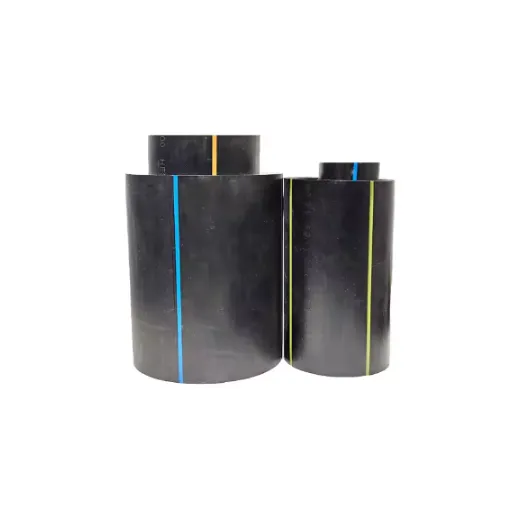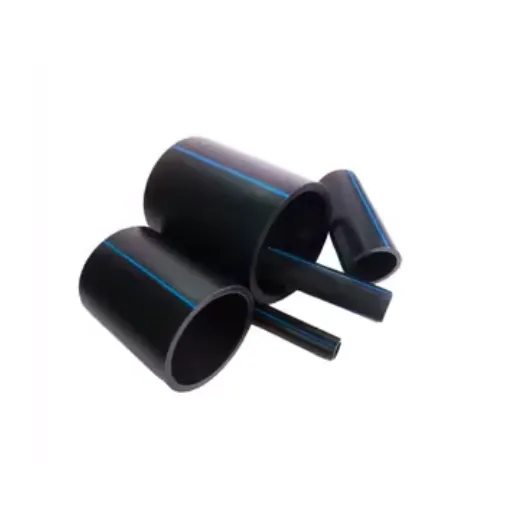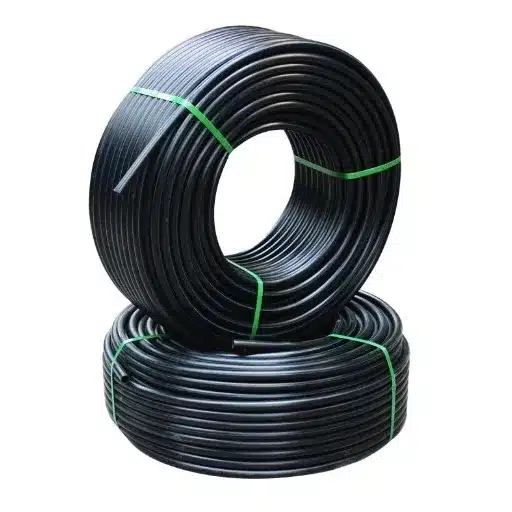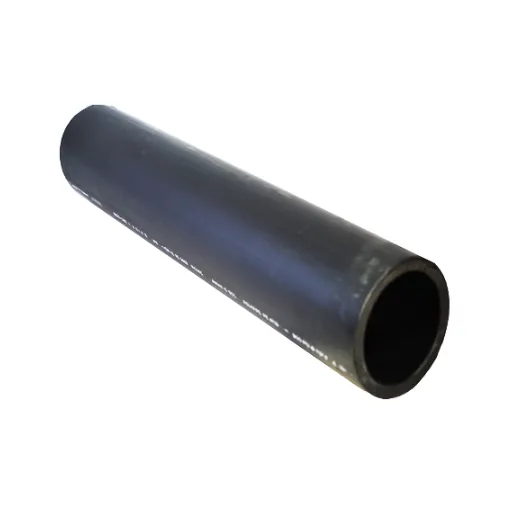With the modern infrastructural emphasis on utility, HDPE pipes have come to be regarded as exceedingly sturdy, flexible, and acutely resistant to corrosion and chemical processes. Correct sizing of pipes serves as an indispensable factor for highest efficiency on water supply systems, gas distribution, or industrial applications. Here, we will discuss intricate issues concerning HDPE pipe sizes in the inches system so as to present a basic understanding of dimensions, applications, and the importance of these pipes in driven industries. If you are anyone in the contractor, engineer, or decision-making domain and need an exact reference for HDPE pipe specifications, then this article is written for you.
Applications of HDPE Pipes Across Industries

Construction and Infrastructure
HDPE pipes are pivotal in construction and infrastructure sectors as they are durable, flexible, and resistant to environmental stressors. Considered an important array of water supply systems, including potable water transportation, due to being considered a non-toxic material with a good life expectancy. They are also crucial in drainage and sewage systems since they can withstand pressure and corrosion while ensuring the reliable disposal of wastewater.
Further, HDPE pipes find their applications underground, particularly in conduits for electrical and telecommunication cables. Given their ability to resist temperature changes and external impacts, they protect sensitive wiring. Being lightweight also facilitates the laying procedure of HDPE pipes in large areas, thereby minimizing the construction period and costs.
Stormwater management constitutes yet another area of application. HDPE pipes are widely used at construction sites and urban developments for the conveyance and retention of stormwater, thereby abating incidences of flooding. This very property plagues their versatility and performance, eventually marking HDPE pipes as a crucial element in modern infrastructure development, sustainable and working for the long term.
Agricultural Uses of HDPE Pipes
Increased flexibility and durability of HDPE pipes make them suitable for agricultural bills. Another application wherein the pipes are very much employed is irrigation, wherein water is supplied to crops via watering or sprinkling systems. Being light in weight and easy to install, the pipes come to great help during large-scale land development. These pipes are highly adaptable to different terrains, thus minimizing the cost associated with labor.
The other area of importance is water conveyance for livestock. HDPE pipes guarantee a clean and dependable water supply, resisting external pressure and harsh environmental conditions. This paramount dependability becomes crucial in a rural setup where water delivery systems operate over long distances without frequent maintenance.
Furthermore, HDPE pipes also come in handy within drainage systems for agricultural lands. It controls excessive clogging so as to ensure the prosperous growth of crops and the degradation of soil. These pipes are impervious to common agricultural chemicals, favoring them for environments exposed to fertilizers and pesticides. All these aspects function as testimonies to make the HDPE pipes a must-have for efficient and sustainable agricultural practices.
Plumbing and Drainage Systems
An efficient plumbing and drainage system forms an important part of the infrastructure that stands over water management in residential, commercial, and industrial areas. Organized delivery of potable water is assured by these systems, coupled with its disposal in terms of wastewater and stormwater. Modern plumbing has been capitalizing on sturdy materials such as PVC and HDPE pipes, which, because of their corrosion resistance, ease of installation, and maintainability, have become a preferred choice in various applications.
Drainage systems serve special purposes ranging from handling heavy rains to preventing flooding and water stagnation. If designed properly, they will have the correct slope gradient, catch basins, and sump pumps for effective operation; for instance, combined sewer systems and separate sewer systems are used in urban areas to take care of stormwater along with wastewater to ensure public safety and sanitation.
Maintenance is key to plumbing and drainage systems because it enables the extension of their operational life and efficiency. Blockages, leaks, and failures are prevented through routine inspections and cleaning that can otherwise cause damage to property or pose health hazards to the public. These standards also include building codes and ordinances issued by authorities such as the International Plumbing Code (IPC), which govern the installation and maintenance of such systems to ensure their compliance with policy on safety or the environment. This goes to emphasize that strong plumbing and drainage infrastructures serve as the backbone for any sustainable water management initiative.
Benefits of Using HDPE Pipes

Durability and Longevity
Durability has always been the argument in favor of HDPE pipes, while comparatively few examples exist for other piping types with shorter instances of operational life. Their ability to ward off the usual environmental stress cracking that other materials have to grapple with is the principal durability feature. The abrasive effects present in typical situations from high hydraulic pressure, chemicals, and temperature extremes would attack HDPE piping material, while the system will remain intact. Hence, HDPE piping material is elastic and flexible enough to apply considerable deformation under changing pressure conditions and survive impact during installation or from accidental high stresses.
In addition, HDPE pipes have much lower failure rates than traditional materials like PVC or cast iron pipes. One study reveals that under ideal installation and maintenance conditions, HDPE pipes can have a service life of over 50 years, making them increasingly cost-effective in the long run. Another advantage is internal resistance concerning scaling or corrosion, which ensures their flow capacity over years. Contrarily, HDPE pipes do not rust or get affected by aggressive environments such as saline water or industrial effluents, unlike metallic pipes, thus being very versatile in their applications.
Longer service life for HDPE piping systems also means reduced replacement or repair frequency, thereby reducing service and environmental disturbance costs. Since thermoses are fused together, sudden leakage is highly improbable in HDPE pipes and joints, contrary to all possible failures of joints in other systems. This reliability is a perfect attribute contemplated in sustainable practices and also pertinent towards acceptance in regulatory requirements, especially on the critical infrastructure projects where durability is outstandingly appreciated. Hence, all these features impart obvious leadership in installation resilience and service life to HDPE pipes for the global water management and drainage systems.
Flexibility and Ease of Installation
The features that best describe HDPE pipes are their unparalleled flexibility and adaptability to a wide range of construction environments. Diverging from rigid piping systems, HDPE pipes can be bent to an acute curvature of 20 to 25 times their outer diameter without affecting their structural strength. This has reduced the need for complicated joint systems and directional fittings, which ease installation and reduce possible points of failure. Whether installed across challenging terrains or on uneven surfaces, they provide a strong and adaptable alternative for dynamic construction environments.
Being light in weight makes installation easier. Compared to traditional materials like concrete and steel, HDPE pipes weigh less and, thus, are a lot easier to transport and handle on-site, thereby reducing time spent on installation and labor costs and allowing for quicker project workflow. The pipes also enable advanced joining techniques like heat fusion to be applied, which result in leak-proof joints and improve system reliability and efficiency over the long haul-from all of which become critical with high-pressure systems and long runs of pipes.
Installation-wise, that is, HDPE pipes throw in some very negligible challenges from the perspectives of the environment and operational effectiveness. The material is inherently impervious to corrosion, chemical attack, or abrasion, enabling it to stand the tests of time without any extra coatings or cathodic protection systems being necessary. From another angle, their seamless compatibility with trenchless installation methods like horizontal directional drilling minimizes the environmental footprint and surface disruption increased by typical pipeline installations. Taken together, the flexibility and installation ease of the HDPE pipes create a complete, economical, and environmentally conscious solution for a range of modern infrastructure projects.
Corrosion Resistance and Cost Efficiency
Traditional materials such as steel, ductile iron, and concrete have been associated with corrosion; on the other hand, HDPE pipes resist corrosion. This resistance emanates from their very chemical composition, which does not allow them to rust or develop pits or scales, irrespective of soil aggressiveness, chemical fluids, or climatic extremities. The following features provide an insight into the corrosion resistance and cost efficiency of HDPE pipes:
- Chemical Resistance: HDPE pipes stand resistant to acids, bases, salts, and most industrial chemicals; they thus never face any performance degradation in chemically harsh environments that require either coatings or liners.
- Long Service Life: Being able to operate within a lifespan of 50 to 100 years in normal working conditions, HDPE pipes offer less replacement and maintenance costs in the long run and hence more value for infrastructure investments.
- Low Maintenance Requirements: Whereas traditional materials require constant inspection and repair to prevent corrosion-related failure, HDPE pipes demand little maintenance, saving much money over time.
- Lightweight Installation: Being lighter in weight, they cut down transportation costs and installation efforts, contributing to the economic advantage while maintaining good resistance during handling and installation.
- Energy-Efficient Manufacture and Operation: Manufacturing of HDPE pipes consumes less energy in comparison to metal pipes, and the smooth interior surface further lowers friction losses, reducing costs on pumping energy during operation.
Together, these characteristics affirm the technical and economic superiority of HDPE piping, particularly in aggressive or unpredictable environments. Its ability to combine durability, easy maintenance, and high performance keeps its demand high for contemporary infrastructure projects.
Installation Best Practices for HDPE Pipes
Preparing for Installation
Proper preparation is important if one wants an efficient and lasting performance from an HDPE pipe system. Execution of the procedure ought to begin with a complete site check for any possible obstructions, soil conditions, and the general suitability of the terrain. A recorded soil analysis would assess the load-bearing capacity and stability, both of which must be sufficient to ensure that the pipe does not deform or fail either during the installation stage or afterward.
Before laying, contractors should confirm that all tools, machinery, and fittings necessary are compatible with the specific HDPE pipe under consideration. Alignments should generally be set in accordance with the engineering design criteria of the job to accommodate any thermal expansion and contraction. The dimensions of the trenches should also conform to industry standards, normally ensuring a minimum trench width of 1.5 times the diameter of the pipe to allow for adequate bedding and backfill.
Another critical consideration is the bedding material consistency. A layer of granular soil, free of large rocks and other foreign materials, should be placed to support the pipe evenly. It requires compaction to minimize voids and direct pressure on the pipe that could generate damage. As the last step, careful quality assurance and inspection processes, such as pressure testing and fusion joint inspection, need to be carried out to ensure that the installation was done without defects or compromises to the structure. Such preparations for the installation maximize the safety, performance, and longevity of the HDPE pipe system.
Techniques for Proper Fitting
To properly fit pipes of HDPE material, it is of utmost importance to carry out precise methodologies to ensure the connections are secure and the system performs effectively. The first consideration is choosing the proper joining method fit for the application and system requirements. Among the common joining methods are butt fusion, electrofusion, and mechanical joining. Butt fusion heating is applied to the pipe ends to soften them to their melting points under controlled temperature. These are then joined under pressure to form a homogeneous connection. It is very much suited to welding long lengths in continuous sections with a minimum amount of leakage at joints.
Electrofusion fittings contain embedded heating elements for securing bonds by applying electric current; they are best for systems with numerous joints or in tight spaces. Mechanical fittings use compression or threading mechanisms to secure tight seals; they are generally employed when fusion is not possible. In all cases, joint preparation will consist of cleaning surfaces of pipes, good alignment of sections, and adherence to a manufacturer’s instructions with respect to temperature, pressure, and cooling times.
To ensure joints have all been correctly installed, non-destructive-type advanced technologies like ultrasonic testing (UT) are used for the assessment of their strength and uniformity in a way of damage to the pipes. Such documentation and adherence to all testing standards, like ASTM, ISO, will ensure more compliance and quality control should they ever be called to arbitration. These procedures themselves contribute to a longer service life of the HDPE piping systems and to a much lower probability of their failure in the period of their operation, even under demanding conditions.
Post-Installation Testing and Inspection
All checks and tests constitute integral components of the post-installation activities of the HDPE (High-Density Polyethylene) pipe system. These activities are conducted to determine the integrity, reliability, and safety of the installation. Several methods are employed to ensure the system meets design or regulatory requirements. Hydrostatic pressure testing, perhaps the most popular, involves pressurizing the newly installed pipeline with water and checking for leakages or deformations under sustained operational pressures.
Another excellent technique uses pneumatically pressurized air. However, air testing is somewhat inherently dangerous if safety considerations are not adhered to properly, so its application is generally limited to smaller pipelines or systems where water testing is not practicable. Visual inspections will also be performed to identify such issues as surface defects, misaligned joints, or any other sign of damage during installation.
Checks by emission of sounds or thermography of the infrared sort can, in fact, isolate potential areas of weakness. Said non-invasive means are highly sensitive to anomalies such as tiny cracks or voids. All test results should be well documented for traceability and compliance, stressing existing standards related to the industry, like ISO 4437 for polyethylene piping systems. By having these exhaustive post-installation testing regimes implemented, operators can guarantee long-term performance while considerably minimizing operational risks.
Comparative Analysis of Pipe Materials

HDPE vs. PVC Pipes
HDPE pipes can flex, resist UV rays, and behave well under extreme conditions, whereas PVC pipes have higher strength, stiffness and are cost-effective in static water applications.
| Aspect | HDPE | PVC |
|---|---|---|
| Flexibility | Excellent | Limited |
| Strength | Moderate | High |
| UV Protection | Yes | No |
| Pressure | Dynamic | Static |
| Connection | Heat Fusion | Glue Joint |
| Expense | Higher | Lower |
| Curvature | Tight | Wide |
| Temperature | Broad Range | Narrow Range |
| Longevity | 100+ Years | 100+ Years |
| Chemical Fit | Varies | Varies |
HDPE vs. Steel Pipes
Both HDPE and steel pipes have their advantages. Steel pipes are generally heavier, stronger, and more resistant to heat, which is why they are preferred in high-pressure applications. HDPE pipes are considered cost-effective, lightweight, and resistant to corrosion.
| Aspect | HDPE | Steel |
|---|---|---|
| Weight | Lightweight | Heavy |
| Corrosion | Resistant | Prone |
| Durability | Long-lasting | Moderate |
| Flexibility | High | Low |
| Pressure | Moderate | High |
| Heat Tolerance | Low | High |
| Cost | Lower | Higher |
| Installation | Easy | Complex |
| Eco-Friendly | Yes | No |
| Lifespan | 50-100 Years | 20-50 Years |
HDPE vs. Concrete Pipes
HDPE pipes are light and corrosion-resistant, and easy to install, as compared to concrete pipes that are heavy, strong, and capable of sustaining heavy loads and are environmentally friendly.
| Aspect | HDPE | Concrete |
|---|---|---|
| Weight | Lightweight | Heavy |
| Corrosion | Resistant | Resistant |
| Strength | Moderate | High |
| Durability | 50-100 Years | 100+ Years |
| Installation | Easy | Complex |
| Eco-Friendly | Recyclable | Sustainable |
| Cost | Lower | Higher |
| Load Capacity | Moderate | High |
| Flexibility | High | Low |
| Maintenance | Minimal | Low |
Maintenance Tips for HDPE Pipes

Routine Maintenance Practices
Ensuring a lifespan and good performance of HDPE pipes makes it necessary to follow maintenance schedules strictly. Several wear and tear situations are considered while performing routine operations to safeguard against failure. Inspection should happen daily; by way of example, it may be visual inspections to detect surface damage, structural deformation, or joint misalignment that could indicate the initial stages of wear. In comparison, it will be more locked and advanced through ultrasonic testing or non-destructive evaluation (NDE) methods to precisely diagnose internal problems without the need to interrupt service.
Cleaning ranks equally among maintenance actions for HDPE pipes. Hydraulic flushing, along with the consideration of which cleaning agents were used, guarantees an appropriate cleaning of pipes from any debris and sediment build-up from obstruction. It is good practice to consider evaluating the environmental factors periodically that might adversely affect the pipe, such as UV radiation and soil pH, so as to anticipate any external factors that could cause undue stress to the material. During storage or handling, HDPE pipes should be kept away from excessive heating and mechanical damage, both of which will aid in speeding the degradation of the pipes.
Joint maintenance also plays an important role. Regular checks along the coupling areas to confirm the integrity of the connections and absence of leakage found in the joints make the job easier. It is advisable to carry out stress analysis that will highlight disparities in pressure and thus subjects that could induce too much strain on the piping system. Maintenance records that document inspection cleaning schedules and situations in which repairs were needed offer valuable information to enhance reliability in the longer term. Putting all these maintenance mechanisms into practice will undoubtedly increase the longevity and efficacy of HDPE pipes.
Extending the Life of HDPE Pipes
To prolong the service life of HDPE pipes, I employ a combination of maintenance strategies aimed at prevention, with monitoring of the system. I carry out periodic inspections with the use of special testing equipment, such as ultrasonic testing or thermal imaging, to detect the earliest signs of wear, damage, or deformation before they become major problems. This way, timely repairs can be done to save big costs due to huge system failures.
Installation is always carefully performed, in conjunction with strict adherence to installation manuals. Proper pipe alignment, joining of pipe fittings invariably reduces stress on the material. I also check chemical compatibility to ensure that exposure does not prevent degradation of the material. This measure protects the pipes’ structural integrity and reduces unnecessary strain placed upon the system.
Besides this, I keep up regular cleaning. I mechanically or hydraulically clean any sediment deposits or blockages, thus maintaining an adequate flow rate and bringing down the internal damage. Keeping the record of maintenance back at the site helps with performance analysis over time and supports the growth of a data-driven decision to prolong the existence of the piping infrastructure. Such measures allow the pipes to consistently perform and promise the prolonged life of HDPE pipes.
Frequently Asked Questions (FAQ)
Q: What are the most common sizes for HDPE pipes in inches?
A: The common sizes for HDPE pipe in inches normally range from 1/2 inch to 63 inches in diameter. Keeping these diameters makes it applicable to several uses, such as water distribution and industrial. The nominal diameter of pipes commonly governs what kind of application it is suitable for.
Q: How does one determine HDPE pipe wall thickness?
A: The wall thickness of HDPE pipes is determined depending on the pipe diameter and the pressure rating necessary for the application. The higher pressure applications require thick walls so that it cannot be deformed and to guarantee the integrity of the pipe. One can not exclude knowledge about HDPE pipe sizes in inches while choosing the suitable wall thickness.
Q: What does SDR mean for HDPE pipe sizes?
A: SDR means Standard Dimension Ratio. It measures the ratio between the diameter of the pipe and the wall thickness. Of course, pipes with low SDR mean thicker walls and higher pressure ratings. This will obviously have a little effect on the sizes and dimensions of HDPE pipes that are available in the market.
Q: Can we use HDPE pipes for high-pressure water systems?
A: Yes, HDPE pipes are used for all high-pressure water systems due to their high strength-to-density ratio and flexibility. Choosing the size and dimension of HDPE pipe plays an integral role in ensuring the pipe’s ability to withstand the specific pressure brought to bear within the application.
Q: What are the different applications of different HDPE pipe sizes?
A: HDPE pipes are also applied in water distribution systems, sewage, and drainage. They can be applied in many different harsh situations that various industries have, including agriculture, construction, and municipal services.
Q: How does one select the correct HDPE pipe size for a project?
A: The choice of the correct HDPE pipe for any project is made by understanding the constraints of particular applications, such as flow rates, pressure ratings, and the environment in which the pipe will be installed. The nominal bore of the pipe and the particular applications must be considered if necessary.
Q: Inside diameters and outside diameters of HDPE pipes: what is their importance?
A: The fast flow rate and giving fast compatibility with fittings and connections are given by the inside and outside diameters of HDPE pipes. The outside diameter has an important bearing on installation, while the inside diameter concerns the flow rate inside the pipe.
Q: Are HDPE pipes available in a variety of sizes and dimensions?
A: Yes, HDPE pipes are prepared in a huge range of sizes and dimensions. The pipe sizes can be customized depending on the particular needs of a project, with common pipe diameters typically ranging from 16mm to 2000mm. Such flexibility allows for tailored solutions in a variety of applications.
Q: What to look for in HDPE pipe dimensions?
A: Consider pressure rating, wall thickness, SDR, and the particular application for which the pipe will be used when looking at HDPE pipe dimensions. Learning this information will help you further select the proper sizes and dimensions for your project needs.
References
- AWWA C906 15 Mcelroy
This document deals with nominal sizes of pipes from 4 inches to 63 inches in diameter, inclusive of specifications. - 331113-Water Distribution Piping, The University of Missouri System
Standard sizes of pipes (4, 6, 8, 12 inches) and their uses are discussed.
Ready to Choose the Right HDPE Pipe?
With this comprehensive guide, you now have the knowledge to make informed decisions about HDPE pipe sizing, installation, and maintenance for your next project.






